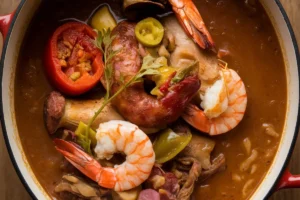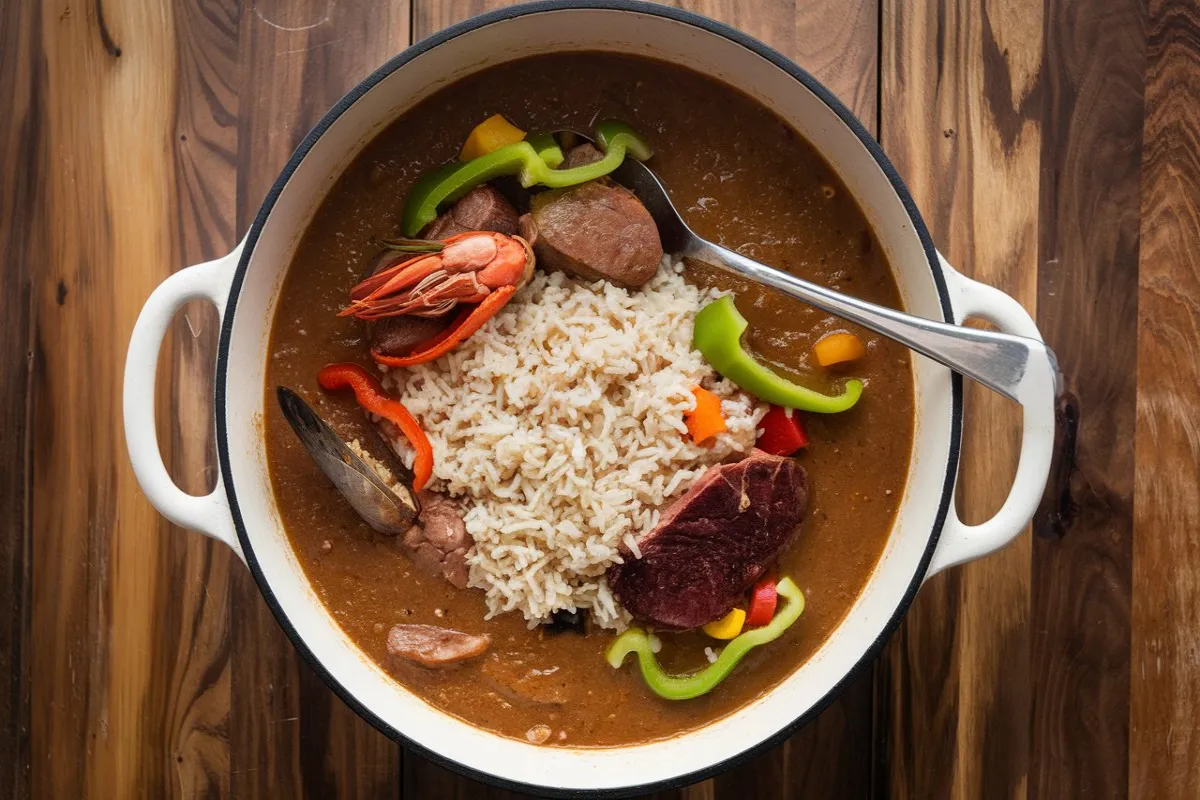Gumbo stands as a quintessential dish in Louisiana cuisine, bringing together the flavors, ingredients, and culinary traditions of several cultures, including African, French, Spanish, and Native American. It’s more than just a stew; it serves as a symbol of cultural blending and adaptation, showcasing the best of Southern cooking. For many, gumbo represents comfort food, evoking memories of family gatherings and celebrations. But what exactly do you need to make a traditional gumbo, and why do so many cherish it?
The Origins and Evolution of Gumbo
Gumbo’s roots stretch as far and wide as its ingredients. The dish likely originated in the early 18th century, when enslaved Africans were brought to Louisiana. The word “gumbo” comes from the West African word for okra, “gombo,” which hints at one of its key ingredients. Over time, gumbo evolved by incorporating elements from French soups and stews, Spanish cooking techniques, and Native American ingredients like filé powder, made from sassafras leaves.
While gumbo recipes can vary significantly, they generally fall into two categories: Cajun and Creole. The primary difference lies in the ingredients and preparation methods. Cajun gumbo uses a dark roux and omits tomatoes, resulting in a smoky, rich flavor. In contrast, Creole gumbo often includes tomatoes and seafood, reflecting a broader range of cultural influences from New Orleans’ Creole community. For more on the distinctions between these styles, you can explore this traditional gumbo recipe.
Core Ingredients of a Traditional Gumbo
To understand what makes a gumbo truly traditional, you need to look at its core components. Each ingredient plays a crucial role in creating the unique flavor and texture that define this beloved dish.
1. The Base: Roux
The heart of any good gumbo is the roux. A roux combines flour and fat, typically oil or butter, cooked together until it reaches a desired color, ranging from light blonde to deep brown. In gumbo, most cooks prepare a dark chocolate brown roux, which adds a rich, nutty flavor and thickens the stew.
- Types of Roux: Light, medium, and dark are the three main types of roux. The darker the roux, the more robust and deep the flavor becomes. However, a darker roux also means less thickening power, so balancing is essential.
- How to Make a Roux: Start with equal parts fat and flour. Cook over medium heat, stirring constantly to prevent burning. It can take anywhere from 15 to 45 minutes to achieve a dark roux. Patience is key!
The roux does more than just thicken gumbo; it lays the foundation for the dish’s depth and complexity.
2. The Holy Trinity of Vegetables
No gumbo is complete without the “Holy Trinity” of vegetables — onion, bell pepper, and celery. These three ingredients form the aromatic base of many Cajun and Creole dishes. When sautéed in the hot roux, they release a fragrant blend of flavors that are essential for a classic gumbo.
- Onion: Adds sweetness and depth.
- Bell Pepper: Provides a mild, sweet flavor with a hint of bitterness.
- Celery: Contributes a slightly peppery, herbal note that balances the other vegetables.
The Holy Trinity is a must-have in any gumbo recipe. Its importance can’t be overstated, as it forms the backbone of the dish’s flavor profile.
3. Proteins
Gumbo is versatile when it comes to proteins, allowing you to use what is readily available or what you prefer:
- Chicken and Andouille Sausage: A staple in Cajun gumbo, these ingredients provide a smoky, spicy flavor. Andouille sausage is a coarse-grained smoked sausage made using pork, pepper, onions, and seasonings.
- Seafood: Shrimp, crab, and oysters are commonly used in Creole gumbo. Fresh, local seafood adds a sweet, briny flavor, which complements the dish’s savory elements.
- Variations: Beyond chicken and seafood, some recipes include more unconventional proteins such as duck, rabbit, or even alligator, offering a unique twist.
Each protein brings its distinct flavor and texture, contributing to the overall richness and diversity of the dish.
4. Herbs and Spices
Gumbo is celebrated for its complex seasoning, which involves a mix of herbs and spices that give the dish its characteristic warmth and depth:
- Common Herbs: Thyme, parsley, and bay leaves are often used for their aromatic qualities.
- Spices for Heat and Depth: Cayenne pepper, paprika, and black pepper are essential for adding a kick of heat and a deep, smoky flavor.
- Filé Powder: Made from ground sassafras leaves, filé powder is used as both a seasoning and a thickening agent, often added at the end of cooking to enhance flavor and texture.
5. Thickening Agents
A defining feature of gumbo is its thick, stew-like consistency. This texture is typically achieved using one or more of the following thickening agents:
- Okra: Often referred to as “the original thickener,” okra not only adds thickness but also lends a subtle grassy flavor. It is commonly used in Creole gumbo.
- Filé Powder: Sassafras leaves are ground into a powder that thickens gumbo when added at the end of the cooking process. It also adds a unique, earthy flavor.
- Roux: As mentioned earlier, the roux also plays a role in thickening the gumbo, particularly when cooked to a medium or dark stage.
The combination of these ingredients gives gumbo its iconic, hearty texture, making each spoonful a rich, savory experience.
6. Stock and Liquids
The foundation of any gumbo is a rich, flavorful stock. The type of stock used will depend on the gumbo variety:
- Chicken Stock: Commonly used in chicken and sausage gumbo.
- Seafood Stock: Essential for seafood gumbo, made by simmering shrimp shells, crab shells, or fish bones with vegetables.
- Vegetable Stock: Used in vegetarian versions of gumbo or when a lighter flavor is desired.
A well-made stock adds depth to the gumbo, enhancing the flavors of the other ingredients. It is typically simmered slowly to allow the ingredients to meld together, creating a broth that is rich and full-bodied.
Preparation Methods and Cooking Techniques

Making gumbo is a labor of love that requires patience and attention to detail. Here’s a step-by-step guide to help you achieve that authentic flavor:
Step-by-Step Process
- Prepare the Roux: Begin by heating equal parts oil and flour in a large pot. Stir constantly over medium heat until the mixture turns a deep chocolate brown. This can take anywhere from 15 to 45 minutes, depending on the desired depth of flavor.
- Add the Holy Trinity: Once the roux reaches the desired color, add the chopped onion, bell pepper, and celery. Cook, stirring frequently, until the vegetables are soft and fragrant, about 5 to 7 minutes.
- Incorporate the Proteins: Add your chosen proteins, such as chicken and andouille sausage, or shrimp and crab. Brown them lightly to enhance the flavor.
- Add the Stock and Seasonings: Pour in the stock and add the herbs and spices, including bay leaves, thyme, cayenne pepper, and paprika. Bring the mixture to a boil, then reduce the heat to a simmer.
- Thicken the Gumbo: Add okra early in the cooking process to allow it to break down and thicken the gumbo. If using filé powder, sprinkle it in at the end of cooking to avoid a stringy texture.
- Simmer Slowly: Let the gumbo simmer for 1 to 2 hours, stirring occasionally to ensure the flavors meld together. The longer it simmers, the more the flavors develop.
Cooking Techniques
- Simmering: Gumbo should be simmered slowly over low to medium heat. This allows the flavors to meld together and the broth to thicken gradually. Avoid boiling, which can cause the proteins to become tough and the roux to separate.
- Timing for Seafood: If using seafood, add it towards the end of the cooking process to prevent it from becoming overcooked and rubbery.
Variations and Modern Takes on Traditional Gumbo
Gumbo is a dish that lends itself to creativity. While the classic recipes remain popular, there are many variations and modern adaptations that cater to contemporary tastes and dietary needs:
Regional Variations
- Gumbo z’Herbes: A vegetarian gumbo traditionally eaten during Lent, made with a variety of greens like mustard greens, collard greens, and spinach.
- Chicken and Andouille Sausage Gumbo: A Cajun staple that focuses on simplicity and deep, smoky flavors.
- Seafood Gumbo: A Creole favorite, often including a mix of shrimp, crab, oysters, and sometimes even crawfish.
Contemporary Adaptations

Modern gumbo variations include options for different dietary needs:
- Vegan Gumbo: Made without animal products, using plant-based proteins like tempeh or tofu and vegetables like mushrooms and zucchini.
- Gluten-Free Gumbo: Replaces the traditional wheat flour roux with gluten-free flour alternatives like rice flour or cornstarch.
These adaptations show that while gumbo has deep traditional roots, it can be adjusted to suit various dietary preferences without losing its essence.
FAQs About Gumbo
- What is the difference between Cajun and Creole gumbo?
Cajun gumbo typically uses a dark roux and does not contain tomatoes, while Creole gumbo often includes tomatoes and has a broader range of ingredients. - Can you make gumbo without okra or filé powder?
Yes, you can use just the roux to thicken gumbo. However, okra and filé powder add unique flavors and textures that are traditional to the dish. - What is the best type of sausage for gumbo?
Andouille sausage is preferred for its smoky, spicy flavor, but other smoked sausages can be used as substitutes. - How do you store and reheat gumbo?
Gumbo stores well in the refrigerator for up to three days and can be frozen for longer storage. When reheating, do so slowly over low heat to preserve the flavors and texture.
Conclusion
Gumbo is more than a dish; it’s a reflection of Louisiana’s vibrant cultural history. With its rich flavors, diverse ingredients, and complex preparation techniques, gumbo has earned its place as a beloved staple in Southern cuisine. Whether you prefer the deep, smoky flavors of Cajun gumbo or the bright, tomato-based complexity of Creole gumbo, this dish offers something for everyone. By experimenting with different ingredients and techniques, you can create your own version of this classic dish that suits your taste and celebrates the rich culinary heritage of the South.

With this guide, you now have the tools and knowledge to make an authentic gumbo that honors its traditions while allowing for personal creativity. So why not gather your ingredients, roll up your sleeves, and start cooking your own pot of this delicious Southern staple today?

